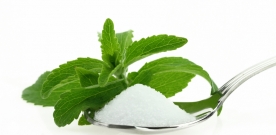HOW TO RULE YOUR DIABETES WITH NATURAL SWEETENERS
Show your pancreas who’s the boss with diabetes-friendly sweeteners: stevia and monk fruit.
Guest Post By: Anna Velazquez, Dominican University Nutrition Student
Are you tired of tiptoeing around every birthday cake or after-dinner dessert with your glucometer? Say no more. Now you can enjoy naturally sweetened, homemade treats and beverages with no added sugar and no spikes in blood glucose. Non-nutritive or artificial sweeteners, those without the dreaded carbohydrates and calories, have been the main option for those of us who can’t enjoy a sugar-rush on demand. The American Diabetes Association supports the use of non-nutritive sweeteners and acknowledges adding them to food may keep your glucose levels in check when used correctly. Though many myths about artificial sweeteners have been debunked, some people still have doubts. If you or a loved one is stressing about the glycemic index of your food and want to avoid artificial sweeteners, you may want to consider using two natural, nonnutritive sweeteners: stevia and monk fruit.
What Are Stevia and Monk Fruit?
Stevia and monk fruit, used for thousands of years by our ancestors, may have some sweet health benefits, which makes them the go-to sweeteners for diabetes management. Stevia is a plant from South America and has been used by natives to give their medicines and drinks a little kick. Likewise, monk fruit has been grown and used by Asian monks as a common remedy in traditional Chinese medicine.
While some people use the actual stevia plant leaves and monk fruit, most of us rely on scientists to isolate the sweet parts, called extracts, which have no calories and offer an intense sweet taste. A recent review of stevia, published in the Archives of Pharmacy Practice, confirmed that stevia appears to be safe and effective for helping diabetics lower their blood sugar when used in moderation. Monk fruit is newer to the sweetener scene. Monk fruit extract is compromised of substances called mogropides, which have antioxidant properties that appear to ward off diabetic complications. In one small study involving mice, mogropides lowered oxidative stress, improved blood glucose, and lowered lipid (blood fat) levels. Although more long term studies are needed, stevia and monk fruit appear to be safe and effect for managing blood sugar.
How To Include Stevia and Monk Fruit In Your Diet
Ready to ditch artificial sweeteners and explore stevia and monk fruit? Here’s the scoop on using both of these natural sweeteners:
Extra tips:
- Look for organic brands and check the ingredient list. Though pure extract is good for your diabetes, the extra additives may not be!
- It’s not magic, it’s science. Stevia or monk fruit may be the watchdog of your diabetes, but it can’t help you with foods that naturally have sugar, like fruit.
- It’s part of a package. Using sweeteners with antidiabetic foods is the key to blood sugar management!
When it comes to diabetes, limiting sugar is a challenge. With alternatives like stevia and monk fruit, you may be able to control your blood sugar naturally and effectively. For more information and quick recipes to help you manage diabetes, download a FREE app from Healthy Eating For Families called Eat Healthy Homemade Meals available on iTunes or Google Play.








posted by Taly Kazimirsky on November 29, 2016
This is such an informative and interesting article! Thank you.